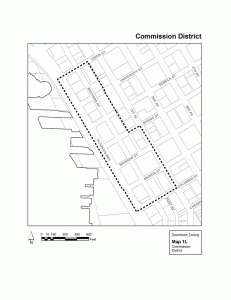 On Tuesday, recommended zoning changes to the Seattle Waterfront were presented to the Planning, Land Use, and Sustainability Committee by the Department of Planning and Development (DPD). The area considered for changes is colloquially known as the “Commission District” and roughly spans from Pike Place Market to Pioneer Square between Alaskan Way and 1st Avenue.
On Tuesday, recommended zoning changes to the Seattle Waterfront were presented to the Planning, Land Use, and Sustainability Committee by the Department of Planning and Development (DPD). The area considered for changes is colloquially known as the “Commission District” and roughly spans from Pike Place Market to Pioneer Square between Alaskan Way and 1st Avenue.
The rules and exemptions proposed by DPD are intended to promote construction of residential, hotel, and street-level retail throughout the neighborhood. While many of the proposed zoning changes are good ideas, they don’t go far enough in providing for a truly pedestrian-centered waterfront.
As mentioned in a previous post, the proposal would make several zoning changes to encourage residential and hotel development through exemptions to floor area ratio (FAR) restrictions, and by designating Western and Alaskan Way as Class I pedestrian streets. The Class I designation brings with it restrictions on storefront utilization and street-level parking complexes in order to encourage active use of the sidewalk and shield the public from parking garage eyesores.
 Some of the proposals may very well have the desired result, but the more effective way to promote pedestrian activity in the area is by significantly reducing the amount of automobile activity. DPD and the City Council could do this by redesigning designating several streets in the area under discussion as woonerfs or as exclusive pedestrian right-of-way.
Some of the proposals may very well have the desired result, but the more effective way to promote pedestrian activity in the area is by significantly reducing the amount of automobile activity. DPD and the City Council could do this by redesigning designating several streets in the area under discussion as woonerfs or as exclusive pedestrian right-of-way.
The streets in question are perfect candidates for the kind of project planned for 12th Avenue next to Seattle University. Anyone who visits the waterfront now can tell you that streets like University and Seneca have limited automobile use already. By designating them as exclusive or priority pedestrian right-of-way, DPD has the option to make them into an extension of the waterfront open space already planned for Alaskan Way. They could also go a long way toward accomplishing their stated goal of creating an “active, pedestrian-friendly frontage” on Alaskan Way, without the use of zoning restrictions.
If city leadership is willing to set an example with this area, the waterfront could be home to a dense, walkable community a stone’s throw from many transit options. The date for the public committee hearing on the proposed zoning changes is July 15th.
Cody Little is a first-time contributor to The Urbanist. He is a naval officer and lifelong resident of the Puget Sound in the process of transitioning to civilian life.



